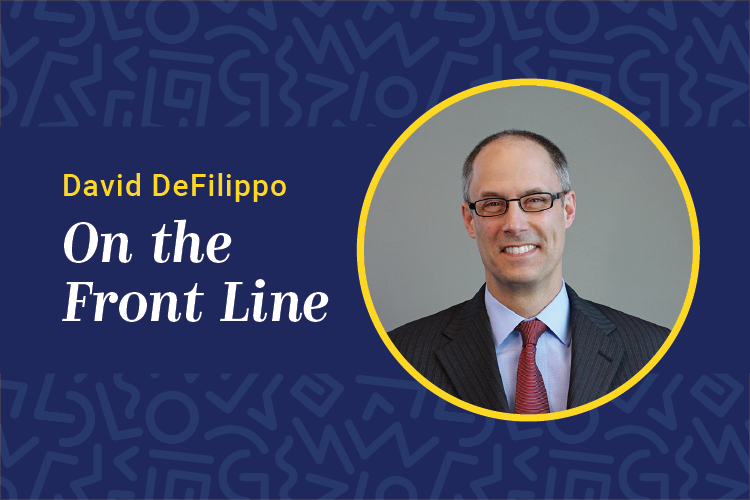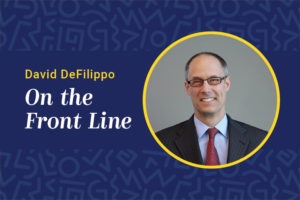
There is a difference between being knowledgeable and owning your various points of view.
by David DeFilippo
December 20, 2019
 It is funny how certain people and experiences can really shape you in a lasting way. I share this reflection as I think back on the many lessons I have learned from mentors in the course of my career. One valuable lesson that I learned about 15 years ago came from a planning session that I was having with Steve Arneson, who was a consultant then and has since become a good friend.
It is funny how certain people and experiences can really shape you in a lasting way. I share this reflection as I think back on the many lessons I have learned from mentors in the course of my career. One valuable lesson that I learned about 15 years ago came from a planning session that I was having with Steve Arneson, who was a consultant then and has since become a good friend.
We were sketching out a multi-year talent management plan and as we made our way from topic to topic, be it leadership development, succession planning or performance management, Steve kept asking me a simple yet powerful question: “What is your point of view on that topic?” This turned the session from a strategic and tactical planning session to more of a coaching session, as I realized that while I had a working knowledge of these topics, I had yet to form a perspective that I could call mine alone. On this day I learned that there is a difference between being knowledgeable and owning your various points of view.
As I walked away from that session I felt enriched because of the plan we had mapped out and curious because Steve made me realize how much I had not thought about what I believed. As a result, I committed myself to both developing my perspective on my profession and being able to clearly articulate those views for both my fellow practitioners and organizational clients. To frame my thinking, I identified the following three inputs to inform and clarify my points of view.
1. Research
I have always enjoyed reading; however, I became a voracious student of the various topics that make up the human capital field. To do this, I subscribed to multiple email lists and sources of regular information on topics such as learning, leadership and talent management to name a few. In doing this, I started my own version of a literature review in which I began to see consistent patterns and divergence among authors and periodicals.
While reading research is a solo affair, I also took the social learning route and joined webinars, networking events and conferences with the explicit goal of taking away at least one specific learning to add to my perspective. For example, I realized that when attending formal conferences 50 percent of the value comes from formal sessions and the other 50 percent comes from one-on-one or small group conversations where people can quickly compare notes on a specific challenge or potential solution. In these ways I became familiar with the seminal works and thought leaders and subsequently built a network in our field to solidify my knowledge base.
2. Experience
As far as the links between research and experience, I am fortunate to have started my corporate career in a front-line role as a UPS driver and then moved into my first people manager role, with my learning and talent practitioner roles coming a few years later. I share this detail only to say that once I shifted into the human capital practitioner space, I realized how invaluable my first-line management experience was in my practitioner work to diagnose issues and develop pragmatic solutions.
Even the best research and thought leadership has to be tested in the real world to evaluate efficacy, particularly when considering a national or global implementation. My time as a manager served as a litmus test for the design and implementation of new or redefined human capital practices. For example, when considering the value in giving regular developmental feedback to employees, what is best way to do so in a highly operational environment where client service is job No. 1? Or, what is the best way to communicate an operating procedure change that impacts the way a team’s work is done?
It is often said that experience is the best teacher; I found that relevant research combined with field experience is an even better way to develop and clarify one’s perspective.
3. Context
Finally, we add context to the mix, or as I like to refer to it — “current reality.” With good intentions, we have all made the mistake of over-relying on our prior experience to develop a recommendation that fell flat, not because it wasn’t a good solution last time, but because that same solution needs to be adapted to one’s current context. Consider the last new role you assumed and the early learning curve where you drew from your prior experiences to deliver wins quickly and, to your surprise, the solution was no longer effective. That unexpected outcome is all about not addressing the nuances of the current state and moving through the change curve too quickly.
So, when asked what your point of view is, my questions for you are:
- Do you have a set of well thought out responses?
- Do you have a process by which to develop your own unique perspective?
- Can you share that point of view in a clear and credible way with internal and external stakeholders?
Your point of view does not have be mainstream or popular, but it does have to be your own. Thanks to Steve’s thought-provoking question all those years ago, I now have a well-honed point of view.



